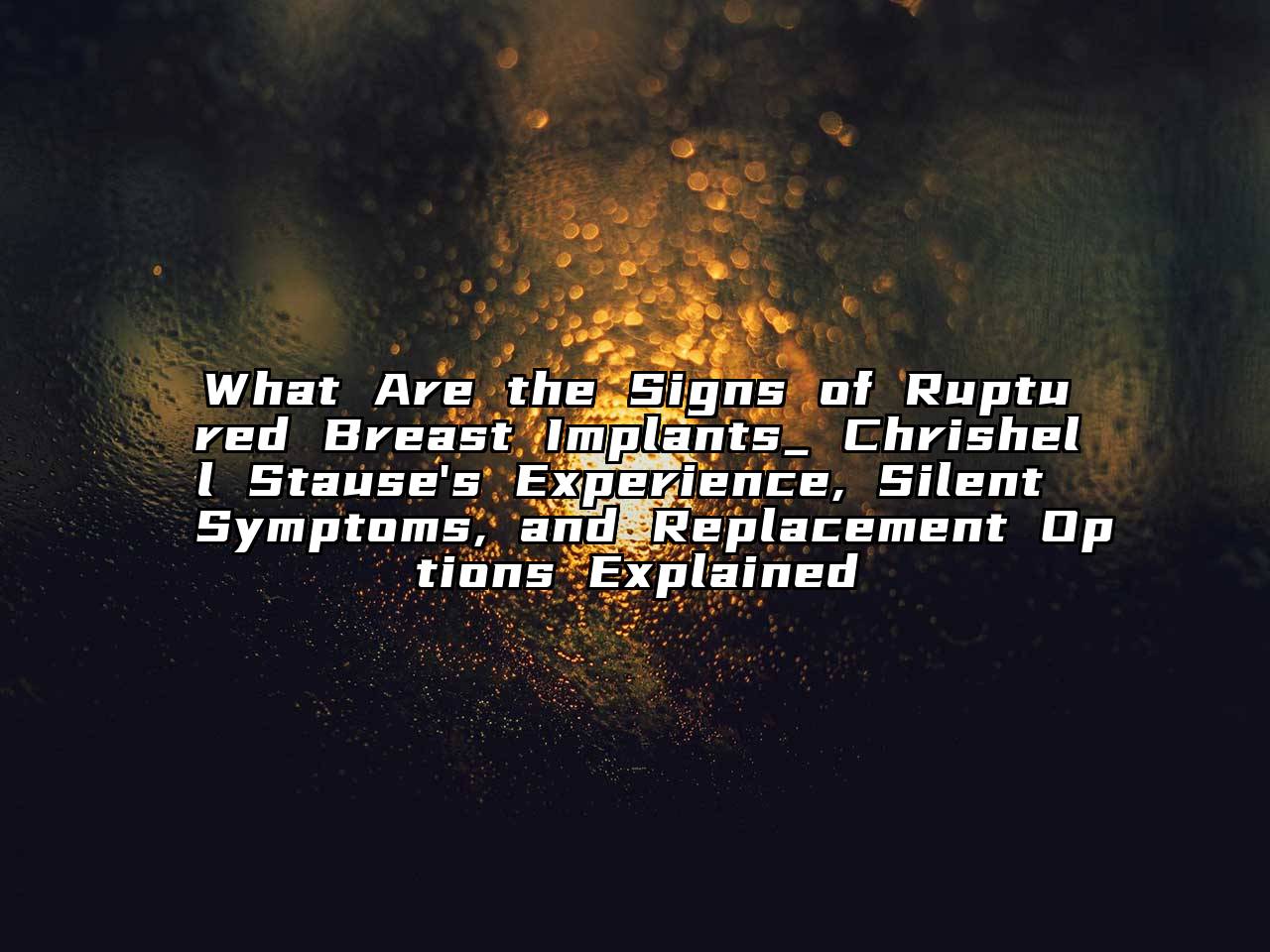What Are the Signs of Ruptured Breast Implants_ Chrishell Stause's Experience, Silent Symptoms, and Replacement Options Explained
The shocking revelation that both of Chrishell Stause’s 15-year-old breast implants had ruptured without noticeable symptoms has ignited crucial conversations about implant longevity and silent health risks. When the Selling Sunsetstar shared her June 2024 surgery journey, she spotlighted a frightening reality: Thousands live with ruptured implants unknowingly, risking long-term complications. This deep dive merges medical expertise, Chrishell’s transparency, and actionable advice to navigate what she calls the "vintage implant dilemma" .
🚨 The Silent Threat: Why Ruptures Often Go Undetected
Chrishell’s case exemplifies three critical realities:

Asymptomatic Nature: Like Chrishell, most patients feel no pain or physical changes when silicone implants rupture. She confirmed: "I didn’t feel any symptoms... It was a surprise".
Delayed Discovery: Ruptures are frequently found incidentally during MRI scans or unrelated medical exams—not self-checks.
Aging Implant Risks: The FDA recommends monitoring implants after 10 years. Chrishell’s 15-year-old "vintage" implants faced higher rupture odds due to material degradation .
💡 Medical Insight: Silicone gel often stays trapped in scar tissue (intracapsular rupture), preventing visible breast shape changes. This creates false security for patients.
🏥 Chrishell’s Surgical Journey: From Fear to Empowerment
Her three-step process demystifies implant revision:
1. The Diagnostic Wake-Up Call
A full-body scan (likely MRI) revealed the rupture—a decision Chrishell made proactively despite no symptoms. Her motivation: "I didn’t like feeling like I could be hurting my body".
2. Surgeon Selection Strategy
With her original surgeon retired, she chose Dr. Josef Hadeed based on:
Specialization in explant surgery
Before/after galleries showcasing natural revision outcomes
Patient testimonials emphasizing compassionate care
3. Surgery & Recovery Insights
En Bloc Removal: Dr. Hadeed removed all silicone and scar tissue (critical to prevent inflammation).
Same-Day Replacement: New implants inserted immediately, avoiding a two-stage process.
"Super Smooth Recovery": Chrishell resumed light duties within days, crediting precise surgical techniques and post-op support from spouse G Flip .
⚠️ Hidden Symptoms: What Chrishell’s Case Teaches Us
While Chrishell felt "nothing," subtle signs exist:
Symptom | Prevalence | Chrishell’s Experience |
|---|---|---|
Breast Hardening | 45% of cases | Not reported |
Swelling/Lumps | 30% | None observed |
Numbness/Tingling | 15% | Suspected minor tingles ("Was that it?") |
Shape Change | <5% | Absent |
Post-Rupture Risks: Untreated ruptures may cause silicone migration, lymph node inflammation, or chronic pain—making Chrishell’s proactive approach vital .
🛠️ Your Action Plan: Monitoring "Vintage" Implants
Follow Chrishell’s advocacy framework:
Step 1: Schedule Diagnostic Imaging
MRI Scans: Gold standard for rupture detection (90% accuracy). Recommended every 2 years post-10-year mark.
Ultrasounds: Cheaper alternative but miss 25% of ruptures.
Step 2: Surgeon Consult Checklist
Ask:
"What’s your en bloc removal success rate?"
"Can you show revision cases similar to my anatomy?"
"What’s your capsular contracture prevention protocol?"
Step 3: Mental Preparation
Chrishell’s advice: "Plastic surgery is personal... but if you have aging implants, get them checked".
💬 The Transparency Debate: Why Chrishell Broke Her Silence
Her Instagram reveal challenged celebrity norms:
Normalizing Revision Surgeries: 43% of augmentations require revisions within 15 years—yet celebrities rarely discuss them.
Rejecting Shame: "I want to be fully open... to help anyone else going through this" .
Balanced Messaging: While advocating health vigilance, she reiterated: "I’m not encouraging anyone to change their body".
🌟 Impact: Her post garnered 500K+ likes, with thousands thanking her for exposing "silent ruptures."
❓ FAQ: Your Top Concerns Addressed
Q: "Can ruptures cause cancer or autoimmune diseases?"
A: No conclusive evidence links silicone ruptures to these conditions per Mayo Clinic—though inflammation risks exist .
Q: "How long do implants realistically last?"
A: 10–20 years, but 20% rupture by decade one. Chrishell’s 15-year lifespan was typical.
Q: "Is replacement surgery riskier than initial augmentation?"
A: Yes—but manageable. Scar tissue complicates surgery, requiring expert techniques like Dr. Hadeed’s capsule removal.
💎 Beyond the Scalpel: The Cultural Ripple Effect
Chrishell’s journey transcends celebrity gossip—it’s a public health intervention. By normalizing implant monitoring without endorsing surgery, she pioneers a nuanced transparency: where empowerment isn’t about perfection, but informed agency. As ruptures in "vintage" implants surge among 90s/00s augmentation patients, her story becomes a lifeline—proving that sometimes, the most radical act is listening to the silence .
Related articles
- Reconstructive Surgery Options at Universitas Hospital Bloemfontein_ How to Navigate Academic Expertise for Trauma, Cancer, and Congenital Corrections
- How Long Is Recovery After Breast Removal Surgery_ Essential Timelines, Aftercare Strategies, and Emotional Healing Guidance
- What Makes Recovery Faster_ Unpacking Danville Plastic Surgery Innovations and How Advanced Techniques Minimize Downtime
- Jhanvi Kapoor Plastic Surgery_ What Natural-Looking Techniques Were Used and How Did Motherhood Influence Her Aesthetic Choices_
- What Non-Surgical Beauty Treatments Are Safe to Use During Cancer Therapy and Recovery Timelines
- How Long Do Results Actually Last_ Examining Are Plastic Surgery Permanent Outcomes and What Influences Their Longevity
- What to Expect During Doll Transformation Recovery in Aventura_ Timeline Planning and Aftercare Strategies from Plastic Surgery Experts
- Considering Plastic Surgery in Gilbert_ Uncover Genuine Reviews of Advanced Institute's Procedures and Patient Experiences
- What to Expect After Pediatric Ear Reconstruction Surgery_ Comprehensive Recovery Timeline and Aftercare Strategies at BONA Plastic Surgery
- Mass General Plastic Surgery Solutions_ What Functional Eyelid Surgery Options Improve Vision and Restore Facial Aesthetics_
- What Experts Reveal_ Analyzing Barry Keoghan’s Transformation and How to Identify Natural Changes vs Cosmetic Enhancements
- What to Expect from Dr. Yash Plastic Surgery Reviews_ Evaluating Natural Results, Recovery Timelines, and Patient Experiences in Dallas
- What are the best long - tail keywords for researching celebrity plastic surgery of Beverly Hills and how to use them effectively_
- What Evidence Suggests Putin Had Botox and Cheek Fillers_ Examining Kremlin Denials, Body Double Theories, and Medical Insights
- What Are the Signs of Ruptured Breast Implants_ Chrishell Stause's Experience, Silent Symptoms, and Replacement Options Explained
- Jayda Cheaves Before Plastic Surgery_ What Procedures Did She Undergo and How to Avoid Her Regrettable Decisions Through Expert Guidance_
